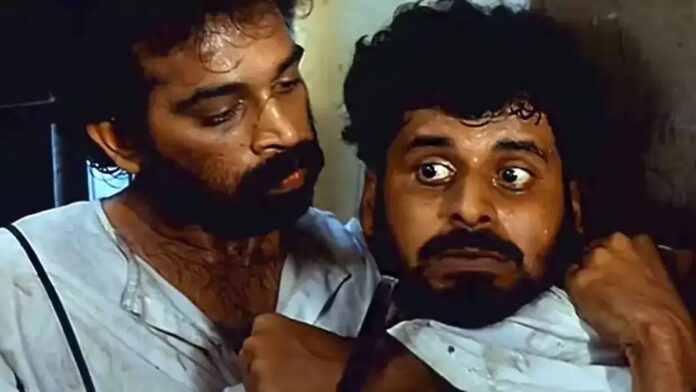A man in his early thirties gets off at CST station in Mumbai, like millions of people who land in the city in search of jobs and a better life. His name is Satya. In the beginning, he is someone who doesn’t bat an eye and is unafraid of death. He has nothing to lose. No family, no relatives, no loved ones. This empowers him to not give in to the demands of a local gangster threatening him with a razor, which he uses to rip apart his jaw later. Satya is aimless. He just wants to do any work and survive. And it is this ghostlike existence, which may have been the result of an extremely troubled past, that takes him into the world of the Mumbai underworld. His cold-bloodedness is gradually given resolve when he meets Vidya, a classical singer staying next door. With her, he is infused with a petal of life little by little, but the danger of his “other” world looms closer.
On a very basic level, “Satya” is a story of a man moving from a state of utter lovelessness and apathy to a shared experience of love. This shift in his thinking happens when he is responsible for the deaths of some innocent civilians in a stampede at a theater. He explains this to his confidante, Bhiku Mhatre, who proclaims that he is the king of Mumbai. They are sitting across the Arabian Sea, which is their usual hangout point. The film invokes Mumbai through such instances. The way these characters speak is a characteristic of the city, where words are mended and given a “Mumbaiya” touch. Through these constant sights of the sea, of the mingling crowd, and the rather rough way of speaking, along with the flapping of pigeons and splashing of rain, Mumbai’s presence is always felt. And it is not the romanticized Mumbai, but rather the Mumbai that is cynical and full of gritty violence. The city has too many flavors. It is the most vibrant during the Ganpati Visarjan in the monsoon every year. And it is no coincidence that the climax of the film is set up with that as a background. An occasion of celebration turns into a visceral murder of vengeance in the middle of a crowd of thousands near the seashore. Our familiar vision of the city is merged with the images of violence that these characters inhabit.
Initially, the city changes Satya; it forces him to boil up his anger and makes him a dreaded gangster. Later, Satya changes the course of the city, causing a menace to its police and the public at large with full-blown shootouts and gang wars in public places. Ram Gopal Varma shoots it with such rawness, taking the camera onto the street at real locations, shooting amidst the public from a high angle in an almost documentary fashion. Coming back to the iconic opening sequence, where we see in quick succession the images of the sea and the bustling life in the metropolis, we hear a voiceover speaking of Mumbai. This unfiltered portrayal of life on the streets, with that shaky camera movement, establishes a jerky style of storytelling that is constant throughout. And we see Satya walking in the crowd from a high angle. He is just one among the many who became the most notorious. The guerrilla filmmaking employed to stay away from the eyes of the people who are not aware of the shoot taking place becomes a part of the narrative in a very strong manner.
One more thing that is inseparable from Mumbai is the incessant rain. And it finds its way into the film at interesting intervals. It is raining when Satya is beaten up by the goons of a gangster, Jagga, on the terrace of a bar overlooking the city. Jagga stands with his umbrella and looks. Later, Bhiku and Satya are going in a car, and they stop at a place. Bhiku tells Satya to go kill Jagga, who is sitting in the bar. Satya goes inside and kills him without a shred of doubt or fear on his face. He comes back and sits in the car. It starts to rain. We see the two laughing from the front window of the car. A circle is complete. Rain and the sounds of rain are also used as an editing device in one striking scene when Chandu is showing Satya his room. The room and the building again invoke Mumbai, where space is less and people are more. Chandu asks him, looking at the photo of God, if he is a believer. He replies in the negative, and we cut to hearing the sound of lightning and heavy rain as we travel to the next scene when the lights go off because of it.
Mumbai becomes a part of the aesthetics in “Satya” so much so that it remains inseparable not just from the story but the treatment. Such amalgamation of the city with the filmmaking is what gives the film that Mumbai feel so that each frame screams of its aftertaste. And so, “Satya” is not “about” Mumbai, but instead, it is a film that inhales Mumbai in telling a story of bloodshed. No wonder, it created what is now known as the ‘Mumbai Noir.’
See More: ‘Gangs Of Wasseypur’ And The Raw Portrayal Of Violence

